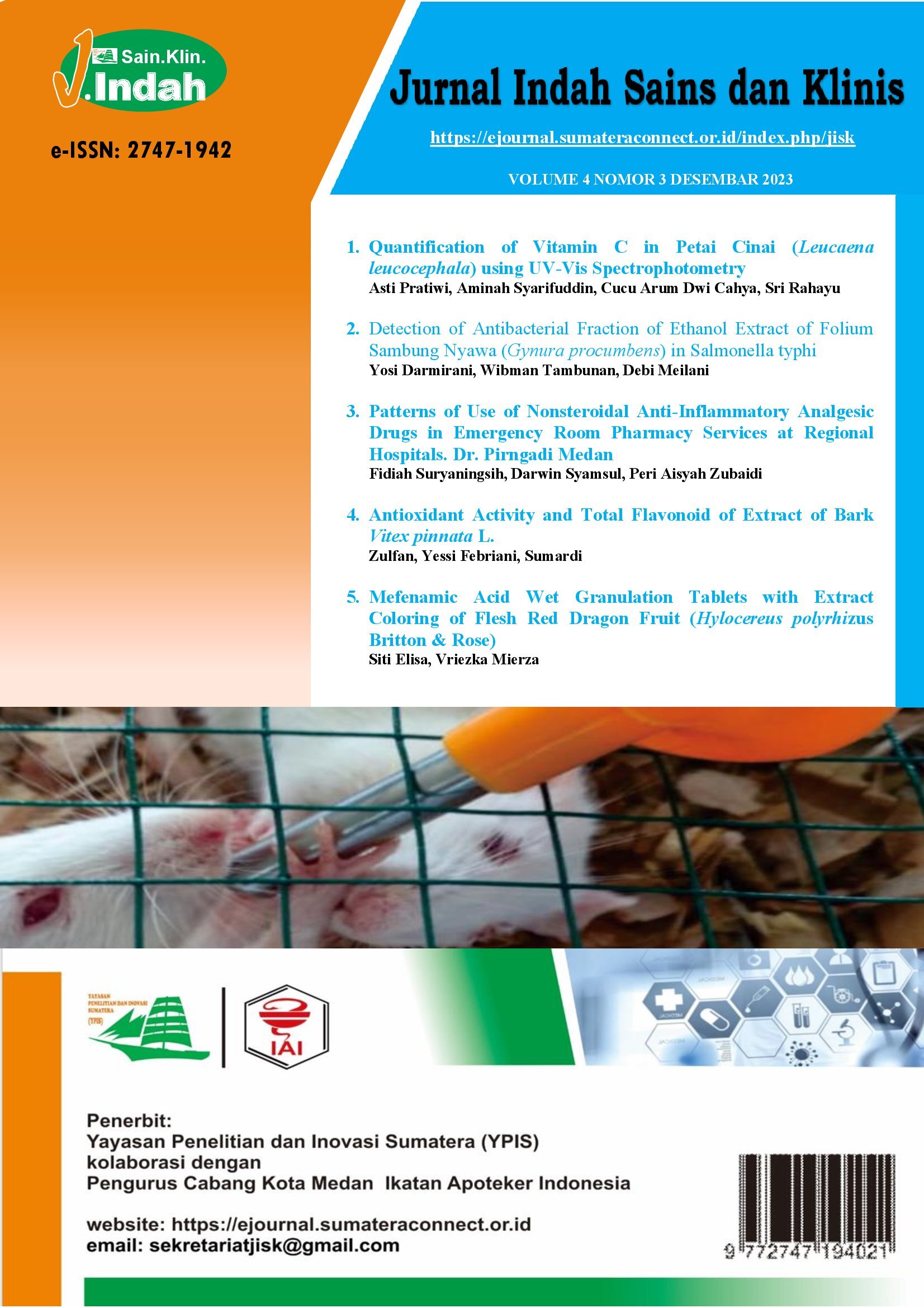Antioxidant Activity and Total Flavonoid of Extract of Bark Vitex pinnata L.
DOI:
https://doi.org/10.52622/jisk.v4i3.04Keywords:
Vitex pinnata, bark, antioxidant, total flavonoidAbstract
Background: The bark of Vitex pinnata L is not yet optimally utilized, primarily being used in boat construction while the remaining material becomes waste that is either buried or burned in trash. Therefore, it is necessary to explore more efficient and economically valuable uses for the bark of the laban tree. Objective: The aim of this research is to identify the chemical compounds, flavonoid content, and antioxidant activity present in the methanol extract of Vitex pinnata L bark. Method: Phytochemical screening was conducted on the methanol extract of Vitex pinnata L. bark. To obtain the extract, the simplicia powder was macerated using methanol as the solvent. The total flavonoid content and antioxidant activity were then tested using the 1,1-diphenyl-2-picryhydrazil (DPPH) method. Results: the phytochemical screening indicated that the Vitex pinnata L. bark extract contains alkaloids, flavonoids, and tannins. The total flavonoid test yielded 17.27%, and the antioxidant activity test revealed that the methanol extract of the laban tree bark has antioxidant activity with an IC50 value of 43.22 ppm. Conclusion: This extract has strong potential as an antioxidant agent.
Downloads
References
Y. Ogata, Y. Kasaharea, and T. Iwasaki, Medicine Herb Index Indonesia, Second Edition. Indonesia: Eisai, 1995.
A. Meena, U. Niranjan, M. Rao, M. Padhi, and R. Babu, “A review of the important chemical constituents and medicinal uses of Vitex genus,” Asian J Tradit Med., vol. 6, no. 2, pp. 54–60, 2011.
H. E. Miller, “Antioksidan Content Of Whole Grain Breakfast Cereals, Fruit and Vegetable,” Jam. Coll., pp. 120–121, 2000.
V. Sreedhar, “In Vitro Antioxidant Activity and Free Radical Scavenging Potential of Roots of Vitex quinata,” Int. J. Chem. Sci., vol. 9, pp. 139–148, 2011.
P. Molyneux, “The Use of The Stable Free Radical Diphenylpicrylhydrazyl (DPPH), For Estimating Antioxidant Activity,” Songklanakarin J. Sci.Technol., pp. 212–219, 2004.
E. Tyler Varro, Pharmacognosy, Seventh Edition. Philadelphia: Jurnal, 1976.
J. B. Harbone, Metode Fitokimia Edisi II. Bandung: Penerbit ITB, 1987.
T. A. Geissman, The Chemistry of Flavonoid Compound. Oxford: Pergamon Press, 1962.
B. M. Sumalatha, S. K. Deprakasih, and M. Tarmizh, “Isolation of Flavonol of Tephrosia purpurea,” Jurnal Ilmu Farmasi Biologi dan Kimia Universitas Bharati, vol. 3, pp. 107–108, 2012.
S. P. Singh and D. K. Pandey, “Alkaloids and Their Therapeutic Potential in Vitex species,” International Journal of Phytomedicine, vol. 12, no. 2, pp. 101–110, 2019.
S. Kumalaningsih, Antioksidan Alami. Surabaya: Trubus Angisarana, 2006.
D. Huang, B. Ou, and R. L. Prior, “The Chemistry Behind Antioxidant Capacity Assays,” J. Agric. Food Chem., pp. 1841–1856, 2005.
T. Samatha, R. Shyamsudarachary, and P. Srinvas, “Quantifacation Of Total Phenoid And Total Flavonoid Content In Extracts Of Oroxylum Indicum L. Kurz,” Asian Journal of Pharmaceutical and Clinical Research, pp. 177–178, 2012.
C. Perwiratami, S. Meiny, and C. Bambang, “Korelasi Fenolat Total dan Flavonoid Total dengan Antioksidan Dari Beberapa Sediaan Ekstrak Buah Tanjung (Mimusops elergi),” Chem. Prog., vol. 7, no. 1, p. 34, 2014.
A. Gupta, “Antioxidant Properties of Flavonoids and Their Role in Prevention of Chronic Diseases,” J Clin Biochem Nutr, vol. 50, no. 2, pp. 147–155, 2018.
A. Dragan, D. Dunsanka, and T. Nenad, “Structure-Radical Scavenging, Activity Relationship of Flavonoid,” Jurnal of Agricultur Strossmayer University, pp. 51–61, 2003.
Y. Chang, M. H. Wen, and J. C. Chern, “Estimation of Total Flavonoid Content in Propolis by Two Complementary Colorimetric Methods,” J. Food Drug Ana., p. 103, 2002.
Neldawati and G. Ratnawulan, “Analisis Nilai Absorbansi dalam Penentuan Kadar Flavonoid untuk Berbagai Jenis Daun Tanaman Obat,” Jurnal Fisika Universitas Negeri Padang, p. 67, 2014.
L. Mirna, A. Jemmy, and J. E. Jessy, “Uji Total Flavonoid Pada Beberapa Tanaman Obat Tradisional Di Desa Waitina Kecamatan Mangli Timur,” Jurnal Kimia Unsrat, vol. 2, no. 1, pp. 50–55, 2013.
E. Mardawati, C. S. Achyar, and H. Marta, Kajian Antioksidan Ekstrak Kulit Manggis (Garcinia mangostana. L) dalam Rangka Pemanfaatan Limbah Kulit Manggis di Kecamatan Puspahiyang Kabupaten Tasikmalaya. Bandung: Fakultas Teknologi Industri Pertanian UNPAD, 2008.
A. Dewi, K. W. Warditiani, and N. K., “Identifikasi Kandungan Kimia Ekstrak Kulit Buah Manggis (Gacinia Mangostana L),” Jurnal Farmasi Udayana, pp. 23–27, 2013.
L. Steroid, “Steroids and Triterpenoids in Cancer Treatment,” Oncol Rep, vol. 34, no. 5, pp. 523–530, 2019.
T. Saponin, “The immunomodulatory Effects of Saponins,” Immunopharmacology Journal, vol. 22, no. 3, pp. 217–225, 2016.
M. J. McCarty, “Glycosides and Their Health Benefits,” Journal of Nutrition and Health Sciences, vol. 47, no. 4, pp. 123–129, 2017.
P. K. Mukherjee, “Plant Tannins and Their Pharmacological Properties,” Phytotherapy Research, vol. 33, no. 2, pp. 233–245, 2018.
Downloads
Published
Issue
Section
License
Copyright (c) 2024 Jurnal Indah Sains dan Klinis

This work is licensed under a Creative Commons Attribution-NonCommercial-ShareAlike 4.0 International License.









 This work is licensed under a
This work is licensed under a 
